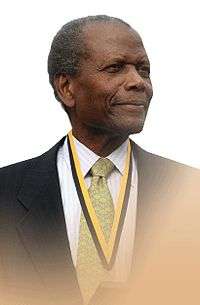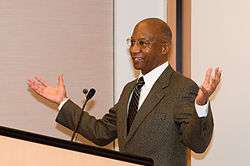Bahamian Americans
|
Notable Bahamian Americans: Sidney Poitier · Klay Thompson · Bert Williams · Kimbo Slice · Roxie Roker · Frederica Wilson · Donald R. Hopkins · James Weldon Johnson · Stepin Fetchit | |
| Total population | |
|---|---|
|
(Bahamian Americans Total Bahamian American Population 180,000) | |
| Regions with significant populations | |
| Florida (South Florida), Georgia (Metro Atlanta), Alabama, New York (New York metropolitan area) | |
| Languages | |
| English (American English, Bahamian English), Bahamian Creole | |
| Religion | |
| Anglicanism · Baptism · Church of God · Methodism · Roman Catholicism · Obeah |
Bahamian Americans are Americans of Bahamian ancestry. There are an estimated 68,000 people of Bahamian ancestry living in the USA as of 2015. Bahamian Americans have been growing at a rate of 58% every decade since 1990, where they were estimated at 21,000 with 90,000 living in the US illegally. [2]
Bahamian Immigration
Bahamians began visiting the Florida Keys in the 18th century to salvage wrecked ships, fish, catch turtles and log tropical hardwood trees. A Bahamian settlement in the Keys was reported in 1790, but the presence of Bahamians in the keys was temporary. Early in the 19th century some 30 to 40 Bahamian ships were working in the keys every year. After 1825, Bahamian wreckers began moving to Key West in large numbers.[3][4] Today, the largest Bahamian American populations are in Atlanta, Oklahoma City, Miami, and New York.
Bahamians built and still reside in the oldest inhabited neighborhoods in Miami like Coconut Grove and Lemon City. Bahamians represented 1/3 of the vote to incorporate the area into the new city Miami
Bahamians were among the first Caribbeans to arrive to the mainland US in the late nineteenth century. Many went to Florida to work in agriculture or to Key West to labor in fishing, sponging, and turtling. Two main factors that contributed to increased Bahamian migration were the poor economic climate and opportunities, as well as the short distance from the Bahamas to Miami. Southern Florida developed Bahamian enclaves in certain cities including Lemon City, Coconut Grove, and Cutler. In 1896, foreign-born blacks compromised 40 percent of the black population, making Miami the largest foreign-born black city in the US aside from New York. Reimers claims that the restrictive immigration policy of the 1920s did not greatly affect the Bahamian émigrés, they continued to migrate in vast number to the US, however many also participated in return migration back to the Bahamas during this time period. Those who chose to remain created institutions in the U.S. During this time in Florida, black Bahamians too faced state-enforced racism. Blacks could not vote, were persecuted by epithets in Miami press, and were not allowed to stay in the hotels that employed them. And in 1921, the Ku Klux Klan staged a large rally attacking these black immigrants in Miami.[5]
2015 estimates.
Communities
The majority of Bahamian Americans, about 21,000 in total, live in and around Miami, Florida, with the Bahamian community centered in Coconut Grove. There is also a growing Bahamian American population in the Atlanta and Oklahoma City areas.
Although the majority of Bahamian Americans live in the Southern United States, a large population can be found in the New York City area, with the population particularly centered in Harlem. Bahamian Americans in the New York City area regularly provide cultural education and entertainment, particularly due to the Office of the Bahamas Consulate General in New York being located in the city.
White Bahamian Americans in Florida were often referred to as "Conchs," and their communities in Key West and Riviera Beach sometimes referred to as "Conch Towns." In 1939, the Works Progress Administration (WPA) conducted a study of white Bahamian Americans in Riviera Beach, eventually published as Conchtown USA.[6]
US communities with high percentages of people of Bahamian ancestry
The top US communities with the highest percentage of people claiming Bahamian ancestry are:[7]
- Bunche Park, Florida 3.80%
- El Portal, Florida 2.20%
- Goulds, Florida 2.00%
- Golden Glades, Florida 1.80%
- Miami Gardens 1.6% in 2010
- Richmond Heights, Florida 1.30%
- West Little River, Florida and North Miami, Florida 1.20%
- Munford, Alabama and North Miami Beach, Florida 1.10%
- Rincon, Georgia 1.00%
- Miami-Dade county 0.35% in 2010
Culture
Bahamian Americans have retained much of their cultural heritage. Bahamian Americans listen to and perform Junkanoo and rake-and-scrape music, engage in the classic art of West Indian storytelling about characters like Anansi, and create Bahamian-style art, especially straw weaving and canvas art.
Bahamian foods staples such as conch, peas and rice, Johnny cake, and desserts including duff (food)s (especially guava) continue to be made by Bahamian Americans. Bahamian dialect is also spoken by many Bahamian Americans, especially in Florida.
Education
As of 2010,Bahamian Americans were the most educated West Indian Americans in the USA. 39.1% of the Bahamian American population of 25 years and over held college degrees. There were 22,763 Bahamian Americans 25 years and older in the country according to the 2010 census. 9.9% held Associates degrees, 17.5% held Bachelors degrees, and 11.7% held Graduate or professional degrees. 29.2% held Bachelors degrees or higher.
[8] In New York State, 46.7% of Bahamian Americans 25 years and older held degrees. 18.5% held Graduate or Professional degrees, 20.6% held Bachelors degrees, with 7.6% holding Associates degrees.
In Georgia 51.1% of Bahamian Americans 25 years and older held college degrees. 18.6% held Graduate or Professional degrees, 25.1% held Bachelors degrees, with 7.4% holding Associates degrees.
In Florida 32% of Bahamian Americans 25 years and older held college degrees. 7.8% held Graduate or Professional degrees, 12.6% held Bachelors degrees, with 11.6% holding Associates degrees. [9]
Economy
In 2010 census the average Bahamian american family household earned $61,070 annually, with the average household earning about $57,000. The median income for family household was $46,196 and the median for household was $42,000.
35 percent of working Bahamian Americans had occupations in Business, science, and arts, 27 percent had positions in sales and office occupations, 24 percent had occupation in service related jobs, 6 percent held jobs in natural resources, construction and maintenance, and 8% in production,transportation, and material moving.
About 20% of the Bahamian American population were living in poverty in 2010. [10]
Organizations
Both the Bahamian American Cultural Society and the Bahamian American Association Inc., the largest Bahamian American organizations in the United States, are located in Manhattan. These organizations provide cultural education services, social opportunities, and genealogical records to Bahamian Americans and those interested in Bahamian and Bahamian American culture.
The National Association of the Bahamas, located in Miami, offers primarily social opportunities for the local Bahamian American community.
The Council for Concerned Bahamians Abroad is a foundation which represents the interests and concerns of Bahamians, and Friends of the Bahamas domiciled outside the Bahamas. Its primary role is to serve as a voice for the economic and family interests of its constituents, and to monitor, analyze, and report on issues and policies that affect these interests. It also operates "Bring It Home Initiatives" (BIHI), projects designed to assist in the development of the Bahamas in seven areas, Education, Business & Industry, Investments & Financial Services, Health & Social Development, Community Development & Sports, Arts & Entertainment, and Tourism.[11]
Notable Bahamian Americans
- Wendy Coakley-Thompson, writer[12]
- Tee Corinne, artist and gay rights activist
- Denzel Curry, rapper[13]
- Lil Duval, comedian
- Kevin "Kimbo Slice" Ferguson, mixed martial artist
- Rick Fox, basketball player
- Donald R. Hopkins, public-health physician, MacArthur Fellow
- J. Rosamond Johnson, musician, composer and performer[14]
- James Weldon Johnson, author, composer and educator[14]
- Lenny Kravitz, musician[15]
- Shakara Ledard, model
- Tahj Mowry, actor
- Tamera Mowry, actress, television host, model, author, businesswoman, singer
- Tia Mowry, actress, model, author, businesswoman, vocalist
- Sidney Poitier, actor[16]
- Al Roker, meteorologist and television personality[17]
- Roxie Roker, actress[15]
- Esther Rolle, actress[18]
- Ryan Sweeting, American professional tennis player
- Klay Thompson, basketball player
- Persia White, actress and singer
- Destinee Walker, UNC women Basketball
- Anastagia Pierre, Miss Universe Bahamas, First black woman to win Miss Florida USA
- Frederica Wilson, U.S House of Representatives from Florida's 24th district
- Bert Williams, Bahamian born American entertainer
- Al Horford, NBA player with from Dominican republic with Bahamian roots
- Stepin Fetchit, was the first black person to become a millionaire from acting
- Eric Gordon, NBA player
See also
References
- ↑ "Total ancestry categories tallied for people with one or more ancestry categories reported 2010 American Community Survey 1-Year Estimates". United States Census Bureau. Retrieved 30 November 2012.
- ↑ Scaled by the previous 5 year growth percentage to get estimated total
- ↑ Viele, John (1994). The Florida Keys: A History of the Pioneers. Sarasota, Florida: Pineapple Press. pp. 13–15. ISBN 1-56164-101-4.
- ↑ Viele, John (2001). The Florida Keys: The Wreckers. Sarasota, Florida: Pineapple Press. pp. 25–28. ISBN 1-56164-219-3.
- ↑ Reimers, David. Other Immigrants: The Global Origins of the American People. New York, NY: New York University Press, 2005. 70-80. Print.
- ↑ Foster, Charles C. 1991. Conchtown USA, with Folk songs & tales collected by Veonica Huss. Boca Raton, Florida: Florida Atlantic University Press. ISBN 0-8130-1042-X
- ↑ "Ancestry Map of Bahamian Communities". Epodunk.com. Retrieved 2008-08-04.
- ↑ "Archived copy". Archived from the original on 2016-04-17. Retrieved 2015-01-02.
- ↑ "Archived copy". Archived from the original on 2016-04-17. Retrieved 2015-01-02.
- ↑ "Archived copy". Archived from the original on 2016-04-17. Retrieved 2015-01-02.
- ↑ "Concerned Bahamians Abroad". The Council for Concerned Bahamians Abroad. Retrieved 30 May 2012.
- ↑ "Wendy Coakley-Thompson, Ph.D." Page One Lit. Accessed July 19, 2007.
- ↑ Denzel Curry Complex Interview
- 1 2 1880 U.S. Census, population schedule, Election Dist. No. 7, Duval County, Florida, Enumeration District [ED] 31, Sheet 23, dwelling 251, household 286, James Johnson household; National Archives microfilm publication T9, roll 156; digital image, http://www.ancestry.com (accessed 31 Dec 2007)
- 1 2 "Roxie Roker, actress and more!" African American Registry. Accessed July 19, 2007.
- ↑ "Sidney Poitier." All About Oscar. Accessed July 19, 2007.
- ↑ ["Al Roker's Family Reunion." Food Network, 2000.]
- ↑ Porter, Darwin. "Introduction to Little Exuma." | Frommers. Accessed July 19, 2007.
External links
- Bahamian American Association
- Bahamian American Cultural Society
- Council For Concerned Bahamians Abroad (CBA)
- Friends of The Bahamas
- National Association of the Bahamas
- Office of the Bahamas Consulate General in New York
- Online version (made available for public use by the State Archives of Florida) of a 1939 WPA exhibit on Bahamian Americans of Florida

.jpg)





